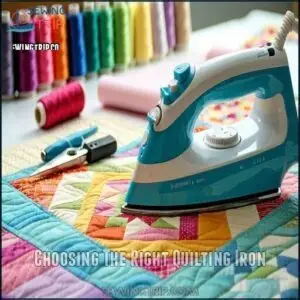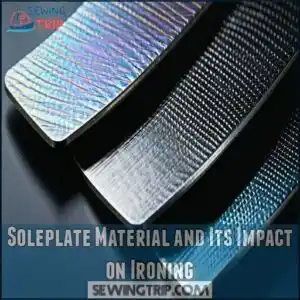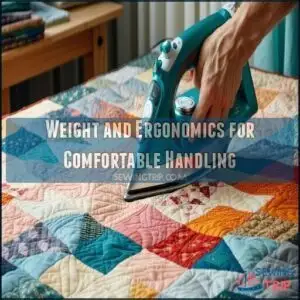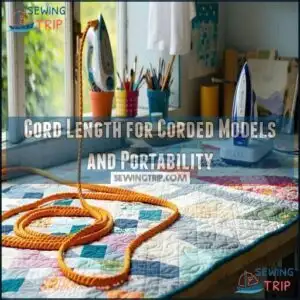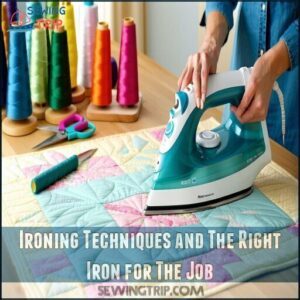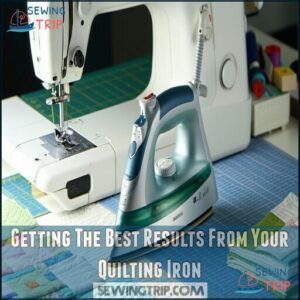This site is supported by our readers. We may earn a commission, at no cost to you, if you purchase through links.
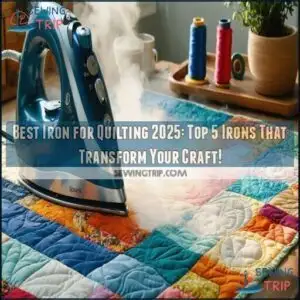
A high-quality quilting iron needs precise temperature control, powerful steam, and a smooth soleplate that glides effortlessly. Ceramic and stainless steel plates offer superior performance, while digital controls let you dial in exact heat settings for delicate fabrics.
Cordless options provide freedom of movement, and features like auto-shutoff keep you safe. Brands like Rowenta and CHI lead the pack with innovative designs that make pressing seams a breeze.
Your perfect quilting companion is waiting – one that’ll make your fabric sing and your projects shine.
Table Of Contents
Key Takeaways
- You’ll want an iron with precise temperature control and powerful steam features that can handle different fabric types, ensuring crisp seams and professional-looking quilts.
- Your ideal quilting iron should have a high-quality soleplate (ceramic or stainless steel) that glides smoothly, distributes heat evenly, and prevents fabric damage during pressing.
- You’ll save time and protect your workspace by choosing an iron with smart safety features like auto-shutoff, leak prevention, and ergonomic design for comfortable handling during long quilting sessions.
- Consider investing in a versatile iron that balances performance and price, with the top models like the CHI Steam Iron or Panasonic Cordless offering professional-grade results without breaking the bank.
Choosing The Right Quilting Iron
When you’re serious about quilting, your iron becomes more than just a household tool—it’s your craft’s secret weapon.
Choosing the right quilting iron can transform your fabric prep from frustrating to flawless, ensuring crisp seams and professional-looking projects that showcase your skill and passion.
Steam Power and Its Importance
Steam is the unsung hero of quilting precision.
Steam: The magic wand that transforms fabric from wrinkled chaos to quilting perfection.
Your iron’s steam power can make or break your fabric’s fate. Here’s why steam matters for quilters:
- Smooth Fabric Transformation: Banish wrinkles with strategic steam distribution
- Precision Pressing: Control fabric shrinkage with consistent steam power
- Seam Perfection: Create crisp, professional edges effortlessly
- Iron Longevity: Optimize your quilting iron’s performance with intelligent steam use
Iron Type – Conventional, Cordless, and Steam Press
After mastering steam power, you’ll want to choose your quilting iron wisely.
Conventional irons offer traditional benefits, while cordless models provide unmatched portability. Steam presses revolutionize your workflow with efficient pressing.
Each type has pros and cons: cordless irons have limitations in run time, traditional irons need constant plugging in, and steam presses take up more space.
Understanding the nuances of different iron types can substantially improve your quilting experience. Your perfect quilting companion awaits!
Sole Plates – Ceramic, Stainless Steel, and Other Options
Exploring soleplate materials transforms your quilting iron’s performance. Choosing the right surface can make or break your crafting precision.
- Ceramic soleplates offer gentle, even heat distribution
- Stainless steel provides unmatched durability and scratch resistance
- Non-stick coatings guarantee smooth fabric gliding
The best quilting iron boasts a soleplate that balances heat conduction, durability, and fabric care. Your choice between ceramic advantages and stainless steel benefits will directly impact your quilting results, making each press count. For those seeking a quality option, consider the ceramic soleplate iron for even heat.
Heat Settings – Adjustable and Fabric-Specific
Your quilting iron’s heat settings are your secret weapon for fabric perfection.
Different textiles demand specific temperatures to prevent damage and achieve crisp, professional results.
Check out this quick reference guide:
| Fabric Type | Ideal Temperature | Risk Level |
|---|---|---|
| Cotton | High | Low |
| Silk | Low | High |
| Polyester | Medium | Medium |
| Wool | Medium-Low | Low |
Choose wisely, and your quilt will thank you, ensuring a professional finish.
Durability and Safety – Auto-Shutoff and Other Features
After perfecting your heat settings, you’ll want an iron that keeps you safe.
Look for quilting irons with robust safety features like:
- Fire-resistant materials protecting your workspace
- Leak prevention systems preventing messy accidents
- Reliable auto-shutoff mechanisms guarding against potential hazards
A durable quilting iron isn’t just a tool—it’s your craft’s guardian, ensuring long-term reliability and uninterrupted creative flow.
Essential Features of a Good Quilting Iron
Your quilting iron is more than just a tool—it’s your secret weapon for transforming fabric into professional-quality masterpieces.
When you choose the right iron with precise temperature control, smooth soleplate materials, comfortable ergonomics, and reliable performance, you’ll elevate your quilting craft from good to extraordinary.
Temperature Control for Precise Heat Settings
In quilting, your iron’s temperature control is your secret weapon for fabric perfection.
With smart digital thermostats, you’ll dial in precise heat settings that protect delicate fabrics from scorching.
Whether you’re working with silky chiffon or sturdy cotton, your temperature control iron guarantees consistent heat recovery and prevents fabric damage.
These advanced features let you confidently press seams and create professional-grade quilting results every single time, achieving fabric perfection.
Soleplate Material and Its Impact on Ironing
After nailing precise temperature control, your iron’s soleplate becomes the secret weapon in quilting perfection.
Consider these material superstars:
- Ceramic soleplates: Glide like silk, distribute heat evenly
- Stainless steel: Tough as nails, resists scratches for years
- Non-stick coatings: Laugh off fusible web residue with easy cleaning
Each soleplate material brings its A-game to your crafting table.
Some retailers offer various soleplate options.
Ceramic benefits shine with smooth fabric navigation, while stainless steel performance guarantees durability.
Your soleplate isn’t just a surface—it’s your quilting companion, transforming raw fabric into masterpiece.
Weight and Ergonomics for Comfortable Handling
Your quilting iron should feel like an extension of your hand, not a workout weight. The right iron balances precision and comfort, preventing wrist strain during marathon sewing sessions.
Your iron isn’t just a tool—it’s your crafting companion, transforming fabric with precision and passion.
| Feature | Impact |
|---|---|
| Weight | Reduces fatigue |
| Handle Design | Prevents hand cramps |
| Balance | Improves control |
| Ergonomics | Enhances performance |
At just 2.2 pounds, lightweight irons like the Panasonic cordless model offer quilters the perfect blend of control and comfort. To prevent mineral buildup, it’s best to use distilled water in your quilting iron, ensuring optimal performance and longevity.
Cord Length for Corded Models and Portability
Your quilting prowess depends on more than just skillful hands—cord length can make or break your pressing experience.
Modern quilting irons offer smart solutions that transform your workspace from cluttered to streamlined.
Key portability factors to keep in mind include:
- Cord flexibility for unrestricted movement
- Quick heat-up capabilities
- Lightweight ergonomic design
- Compact storage potential
- Hassle-free cord management
Corded models with 8-10 foot lengths provide exceptional workspace mobility, letting you glide from cutting table to ironing board without constant repositioning.
Cordless options like the Panasonic model eliminate cord frustrations entirely, offering complete freedom during delicate pressing tasks.
Smart cord management systems—think retractable designs and strategic swivel points—keep your quilting area tidy and prevent potential cord damage.
Whether you’re working in a compact craft room or attending a quilting workshop, the right iron’s cord length can substantially enhance your creative workflow.
Top 5 Best Irons for Quilting
Your quilting journey deserves the perfect iron to transform your craft from good to great.
We’ve carefully selected the top 5 irons that’ll help you press, steam, and smooth your way to professional-looking quilts with precision and ease.
1. CHI Steam Iron with Titanium Soleplate
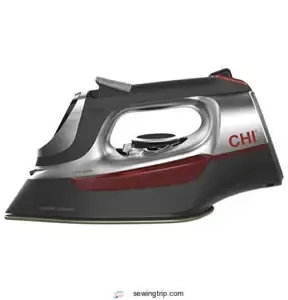
Transform your quilting experience with the CHI Steam Iron, featuring a titanium-infused ceramic soleplate that glides like butter across delicate fabrics.
Its impressive 400+ steam holes work overtime, distributing steam evenly and banishing wrinkles with professional precision.
The electronic temperature control takes the guesswork out of fabric pressing, displaying exact settings for everything from delicate cottons to heavyweight linens.
Powered by a robust 1700-watt system, this iron heats up fast and maintains consistent temperature, letting you zip through seam after seam without pause.
Considering its scratch-resistant sole plate, it’s built for durability.
The 8-foot retractable cord gives you plenty of workspace freedom, though you might need to sweet-talk the cord into retracting smoothly.
It’s not just an iron—it’s your quilting project’s secret weapon.
Best For: Quilters, crafters, and frequent ironers who need precise temperature control and powerful steam for heavy fabrics.
- High steam output may require frequent refilling of the water reservoir.
- Retractable cord can be finicky to retract fully.
- Slightly top-heavy design may take adjustment for some users.
- Titanium-infused ceramic soleplate glides smoothly and resists scratches.
- Over 400 steam holes ensure even and powerful wrinkle removal.
- Electronic temperature control provides precise fabric settings.
2. Panasonic Cordless Multi-Directional Iron
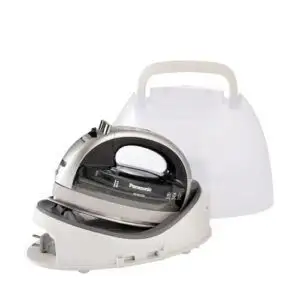
Cutting the cord on traditional ironing, the Panasonic NI-WL600 Cordless Multi-Directional Iron revolutionizes your quilting workflow.
Its 1500W power and 360-degree stainless steel soleplate deliver unmatched precision for intricate fabric work.
With temperatures spanning 176°F to 392°F and a convenient detachable water tank, you’ll breeze through projects.
The auto-shutoff feature and heat-resistant carrying case add safety and portability.
Priced at $129.95, this iron offers professional-grade performance without the hassle of tangled cords.
Best For: Quilters and home users seeking a cordless iron with precision for intricate fabric work and portability.
- 360° stainless steel soleplate for smooth, multi-directional ironing.
- Detachable water tank ensures easy and spill-free refills.
- Auto-shutoff and heat-resistant carrying case enhance safety and storage.
- Initial use may require multiple attempts to optimize steam output.
- Dry iron setting alone may not remove all wrinkles.
- Limited 1-year warranty may not suffice for long-term needs.
3. Rowenta Eco Intelligence Steam Iron
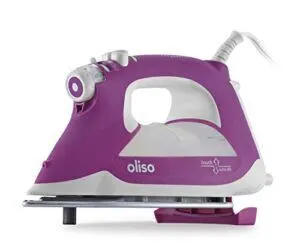
Ever wondered why quilters rave about the Rowenta Eco Intelligence Steam Iron? This German-engineered marvel boasts a stainless steel soleplate with 400 micro-holes that distribute steam like a pro.
Its energy-saving Eco mode cuts power consumption by 30% without compromising performance. With a built-in anti-calc system and 3-way auto-off feature, it’s both smart and safe.
The slightly heavier design provides stability, while powerful steam penetrates even the thickest fabrics. For quilters seeking precision and efficiency, this iron is your new best friend.
Best For: Quilters and fabric enthusiasts seeking precision, energy efficiency, and professional-grade steam performance.
- Heavier design may not suit users looking for lighter ironing options.
- Can be pricey compared to simpler models.
- Anti-drip system may struggle with very low-temperature settings.
- Energy-saving Eco mode reduces power use by 30% without sacrificing efficiency.
- Stainless steel soleplate with 400 micro-holes ensures even steam distribution.
- Built-in anti-calc system and 3-way auto-off enhance durability and safety.
4. Rowenta Micro Steam Iron DW5080
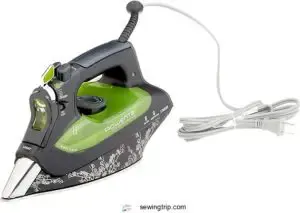
Powering through quilting projects demands a reliable iron, and the Rowenta Micro Steam Iron DW5080 rises to the challenge with German precision engineering.
Its 1700-watt performance and stainless-steel soleplate boast 400 microsteam holes that distribute steam like a pro, ensuring every seam and fabric receives perfect attention.
The precision tip slides into tight corners with ease, while the intuitive thermostat knob lets you dial in exactly the right temperature for delicate or heavyweight fabrics.
With three steam settings—including an energy-saving eco mode—you’ll have ultimate control over your pressing technique.
The generous 7.9-foot cord gives you plenty of workspace freedom, and built-in safety features provide peace of mind.
A 3-way auto shut-off protects against accidental burns, activating after 8 minutes standing, 30 seconds face-down, or if tipped over.
This iron isn’t just a tool—it’s a quilting companion.
Best For: Quilters, sewers, and anyone needing a high-performance iron for precision tasks and heavy-duty ironing.
- Powerful 1700 watts with rapid heat-up and exceptional steam distribution for efficient ironing.
- Precision tip and 400 microsteam holes ensure smooth handling of corners and complex fabric areas.
- Energy-saving eco mode and durable anti-calc system extend the life of the iron.
- Slightly heavier design may be tiring for prolonged use.
- Larger water tank can make it less compact for travel.
- Premium price compared to standard irons.
5. Black Decker Digital Advantage Steam Iron
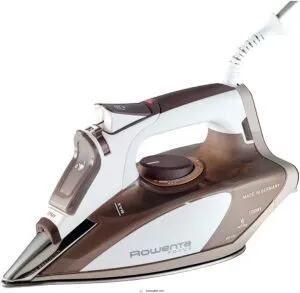
The Black & Decker Digital Advantage Steam Iron emerges as a quilting companion that punches well above its weight class.
Its digital temperature controls offer laser-precise heat settings for different fabric types, while the stainless steel soleplate glides effortlessly across delicate quilting materials.
You’ll love how this iron maintains consistent high temperatures that flatten stubborn seams without breaking a sweat.
The thoughtfully balanced weight provides natural pressure for pressing multiple fabric layers, reducing wrist strain during those marathon crafting sessions.
With a generous water reservoir, you’ll breeze through multiple quilt blocks without constant refills.
Though not exclusively marketed to quilters, this iron delivers professional-grade results at a wallet-friendly price.
The innovative 3-way auto-shutoff feature adds a safety net for those moments when creativity completely absorbs your attention, making it a smart investment for serious and casual quilters alike.
Best For: Quilters and crafters looking for a budget-friendly steam iron with precise temperature control and reliable performance.
- Not specifically designed for quilting, though highly effective.
- Lacks advanced features found in premium models.
- Auto-shutoff can interrupt long crafting sessions.
- Digital temperature controls for precise heat settings on fabric types.
- Balanced weight design reduces wrist strain during extended use.
- Generous water reservoir minimizes frequent refills.
What to Consider When Buying a Quilting Iron
When choosing a quilting iron, you’ll want to examine several key factors that can make or break your crafting experience.
Your perfect iron should balance steam power, heat settings, soleplate material, and safety features to guarantee smooth, professional-looking quilting results.
Your Budget and Finding The Best Value
Let’s price-shop like a quilting pro! Your ideal iron doesn’t mean breaking the bank. Budget options range from wallet-friendly ($30-70) to professional-grade ($150-300), with mid-range models ($80-150) offering sweet-spot value.
- Picture your dream quilt transforming under a perfectly heated iron
- Imagine saving fabric costs with a smart, long-lasting purchase
- Visualize investing in quality that pays dividends through precision
Quilting iron reviews reveal smart shoppers prioritize:
- Warranty coverage
- Steam performance
- Durability potential
Comparing features against price helps you select the best quilting iron without compromising craft quality. Consider that many recommend filtered water usage to prevent mineral buildup. Your perfect match balances cost, performance, and reliability.
Ironing Techniques and The Right Iron for The Job
After finding your budget-friendly iron, mastering ironing techniques becomes your next quilting superpower.
Different fabrics demand unique pressing approaches, from delicate cotton to sturdy wool.
The best quilting iron matches your fabric preparation needs—lightweight for precision seam work or powerful steam for blocking techniques.
Consider your project’s complexity: intricate piecing requires finesse, while large quilt tops need robust steam and consistent heat.
Your iron isn’t just a tool—it’s your craft’s secret weapon.
Getting The Best Results From Your Quilting Iron
Mastering your quilting iron is the key to transforming rough fabric into professional-looking masterpieces.
With the right techniques and knowledge, you’ll learn how to press seams, manage steam settings, and care for your iron to achieve crisp, precise results every time.
This will help you achieve crisp, precise results and ensure that your quilts look professional and well-made.
Ironing Seams and Edges for a Professional Finish
Every quilter dreams of picture-perfect seams that elevate their craft from homemade to professional.
Your quilting iron is the secret weapon for achieving those crisp, clean edges that make judges and fellow crafters nod in appreciation.
Here’s how to master seam pressing like a pro:
- Set your iron to medium-high heat (350°F for cotton)
- Press seams consistently to one side
- Apply firm, steady vertical pressure
- Double-check both fabric sides for hidden tucks
Patience transforms ordinary piecing into extraordinary quilting artistry.
Using Steam for Efficient Ironing and Wrinkle Removal
Your steam iron is your secret weapon for quilting perfection. Master steam temperature and techniques to transform wrinkled fabric into crisp masterpieces.
A strategic steam burst can smooth stubborn creases faster than you’d imagine. Pro quilters know water quality matters – use distilled water to prevent mineral buildup and protect your steam iron’s performance.
Steaming cotton helps to freshen the fabric. By understanding your iron’s steam power and maintaining its delicate mechanisms, you’ll elevate your quilting from good to extraordinary.
Keep your tool clean, and it’ll keep your projects pristine.
Tips for Ironing Different Fabrics and Materials
The quilting iron is your fabric’s best friend, transforming wrinkled materials into smooth masterpieces.
Your heat settings are the secret weapon for fabric perfection.
- Always test temperature settings on scrap fabric to prevent costly mistakes
- Follow fabric grain direction to maintain material integrity
- Use a protective cloth when pressing delicate surfaces
Cotton craves high heat with light steam, while silk whispers for gentle, low-temperature caresses.
Wool demands medium settings and a protective barrier.
Remember: each fabric has its unique personality, and your quilting iron speaks its language.
Maintenance and Care for Your Quilting Iron
Your trusty quilting iron needs tender loving care to keep performing like a pro.
A well-maintained iron is your crafting companion, preventing frustrating malfunctions and ensuring crisp, professional results.
| Maintenance Task | Recommended Action |
|---|---|
| Soleplate Care | Clean with vinegar-water solution |
| Steam Vent Clearing | Use filtered water regularly |
| Storage | Keep upright on heat-resistant surface |
Routine checks and gentle cleaning will extend your iron’s lifespan substantially, and it is crucial for preventing frustrating malfunctions.
Frequently Asked Questions (FAQs)
Which iron is best for quilting?
Strike while the iron’s hot!
You’ll want the Oliso TG1600 Pro SmartIron for quilting.
Its ceramic soleplate, iTouch technology, large water tank, and precision tip make it a superior choice for crafting perfect, wrinkle-free fabric masterpieces, utilizing its iTouch technology.
What is the best steam iron for quilting?
You’ll want the Oliso Pro TG1600 for quilting—its smart lift technology prevents scorching, provides precise steam control, and offers an ergonomic design.
That will make your fabric pressing smooth and effortless without breaking the bank, utilizing precise steam control for optimal results.
What is the best iron for quilting in 2024?
Like a skilled artist wielding a magic wand, you’ll transform fabric with the Oliso Pro TG1600.
Its smart lift technology, precise steam control, and ergonomic design make it the ultimate quilting companion for crisp, professional results.
Which cordless iron is best for quilters?
You’ll love the Panasonic Cordless Iron for quilting.
Its multi-directional soleplate, adjustable steam, and auto shut-off feature make it a game-changer.
Stay nimble and precise with this ergonomic, cordless companion that’ll revolutionize your fabric pressing experience.
What is a quilter iron?
90% of quilters swear by specialized irons.
A quilter’s iron is a precise, steam-powered tool designed to press fabric with accuracy, featuring adjustable heat settings, smooth soleplates, and ergonomic design for creating crisp, professional-quality quilt seams and blocks.
Do quilters use irons?
Yes, irons are essential tools for quilters! You’ll use them to press seams, create crisp edges, flatten fabric pieces, and guarantee precise alignment during every stage of your quilting project.
Should you buy an iron for sewing & quilting?
Just as a seamstress needs a sharp needle, you’ll need a reliable iron for sewing and quilting.
An iron transforms wrinkled fabric into crisp, professional pieces, making it an essential tool that elevates your crafting precision and final project quality, with reliable use.
Is a dry iron or steam iron better for quilting?
Steam irons are your go-to for quilting.
They’ll tackle wrinkles and press seams more effectively than dry irons, giving you crisp, professional-looking results with their versatile heat and moisture control across different fabric types.
What iron does the Missouri Star quilt Company use?
Like a trusty sidekick in a crafting adventure, the Missouri Star Quilt Company swears by the Oliso TG1600 Pro SmartIron.
You’ll love its iTouch technology, ceramic soleplate, and automatic lift to prevent fabric burns.
What is the best Rowenta iron for quilting?
You’ll love the Rowenta DW7180 for quilting.
Its self-cleaning feature, 400 steam holes, and stainless steel soleplate make precise pressing effortless.
With energy-saving settings and professional performance, it’ll become your quilting companion in no time.
Conclusion
Quilters spend an average of 120 hours per project, making the right iron essential.
Your perfect quilting companion awaits among these top-rated models.
Whether you’re pressing delicate batik or sturdy cotton, the best iron for quilting transforms your craft from good to exceptional.
Invest wisely, master your technique, and watch your quilting projects come to life with crisp, professional seams that showcase your incredible skill and creativity.

